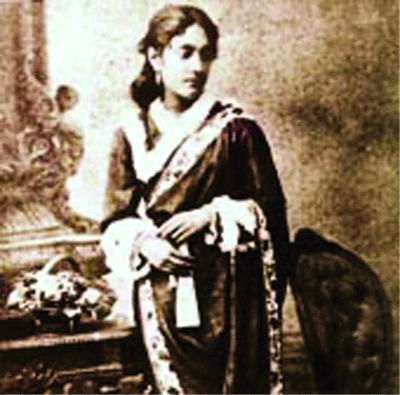Jnanadanandini, wife of Satyendranath Tagore, elder brother of Rabindranath Tagore, introduced the lifestyle of a nuclear family to Bengal and also taught women the Parsi way of draping sari. Sharmila Tagore spoke to Karan Bhardwaj about the legendary legacy of Tagore family
Did you know that Jnanadanandini, wife of Satyendranath Tagore, elder brother of Rabindranath Tagore and the first Indian to enter the Indian Civil Service in 1863, played a key role in the opening of the “zenana” (an area where women were kept in seclusion) in the elite households of the 19th century in BengalIJ The woman was touted to be much ahead of her times, and also introduced the concept of “nuclear family” within the walls of Jorasanko, Tagore’s ancestral house. Since she was the wife of a senior bureaucrat, she became the first lady to wear an Oriental dress — a Mughal style kurta and voluminous pants — when she was out with her husband. Interestingly, the lady also changed the way a sari was draped in this country. “Earlier the six-yard fabric was worn in a single sheath without pleats, and there were no blouses. It was so difficult to carry that women had to bend downwards to stand or walk properly. However, Jnanadanandini introduced the Parsi way of draping the sari. Thanks to her that we can now wear saris with pleats or around shoulders in different ways. She even gave advertisements in newspapers about this new draping style and interested women could approach her to the learn it,” said actor Sharmila Tagore, great-grand daughter of Rabindranath Tagore.
Since centuries Rabindranath Tagore and everything related to him has strongly defined Indian culture. Many scholars and authors have written about him, his upbringing and his family, with men taking the lead. What remained under shadows was the personality and multilayered lives of the women from the Tagore family.
Sharmila discussed the legacy of women from the Tagore family with author Aruna Chakravarti, who wrote Jorasanko earlier this year, at the Taj literature Festival. Aruna’s book documented the life and multi-dimensions of Tagore women in a fictional format. However, most of it is based on reality. “Since there was not much written about them, I had to consult a lot of people close to this family before I sat down to write the book,” said the author.
Digambari, wife of Dwarakanath, Rabindranath’s grandfather, was an obedient wife but an assertive woman.
Though she was clear in conscience, she was made to pay for her husband’s deeds, which she never approved of. The feisty woman even startled pundits of her times. Dwarakanath had given in to British privileges and would often get them home to offer flesh and drinks. Despite being in purdah, Digambari was absolutely against this culture of wine and meat. She called a conclave of Brahmin pundits to define her “dharma”. Whether to follow rituals or the unruly diktat of her husband was the questionIJ Pundits advised her to stay on her husband’s side but with a reformed life. She was told not to co-habitat with Dwarakanath. But if he touches her, for whatever reason, she would have to undergo rituals including taking a bath with seven pots of Ganga jal. “And the poor woman died of pneumonia,” said Sharmila adding that it was always women who bore the brunt of patriarchal legacy. “Men in the Tagore family were detached from the women. While they were busy living independent lives, women partners either craved for them or led a melancholic life. However, a few of them also broke the notion,” she said.
Kadambari Devi, the wife of Jyotirindranath and sister-in-law of Rabindranath, was devoid of love. In the end, she took her own life. She was an intelligent woman with well-refined knowledge and was also the muse for Rabindranath’s many works. She could never get attention of her husband. “She was under the impression, which was also supposedly true, that Jyotirindranath had an affair with a famous actress (Gulab Sundari) of that time. She had no sense of self-worth,” Aruna said.
Though Rabindranath was friends with her, he never took responsibility for an altered mind of the lady.
“Rabindranath’s marriage was also a shock for Kadambari. She felt cheated,” said Sharmila adding that the poet was being a conformist for his own family. “He was a forward-thinking man for the world but a different Rabindranath for women of his family. It was he who opposed the remarriage of one of his granddaughters,” she said.
The actress also lambasted her great grandfather for being apathetic of his wife. “look at the things these men have done to their women. He asked his wife (Mrinalini Devi) to organise everything for one of their daughter’s marriage in just three days. The poor lady did it all despite her sufferings due to appendix. Ultimately, her appendix burst which caused her death at a young age of 29,” she said.
Despite the turbulence Tagore women faced in lives they were cult personalities of their times, and shaped India in more than one way.


























